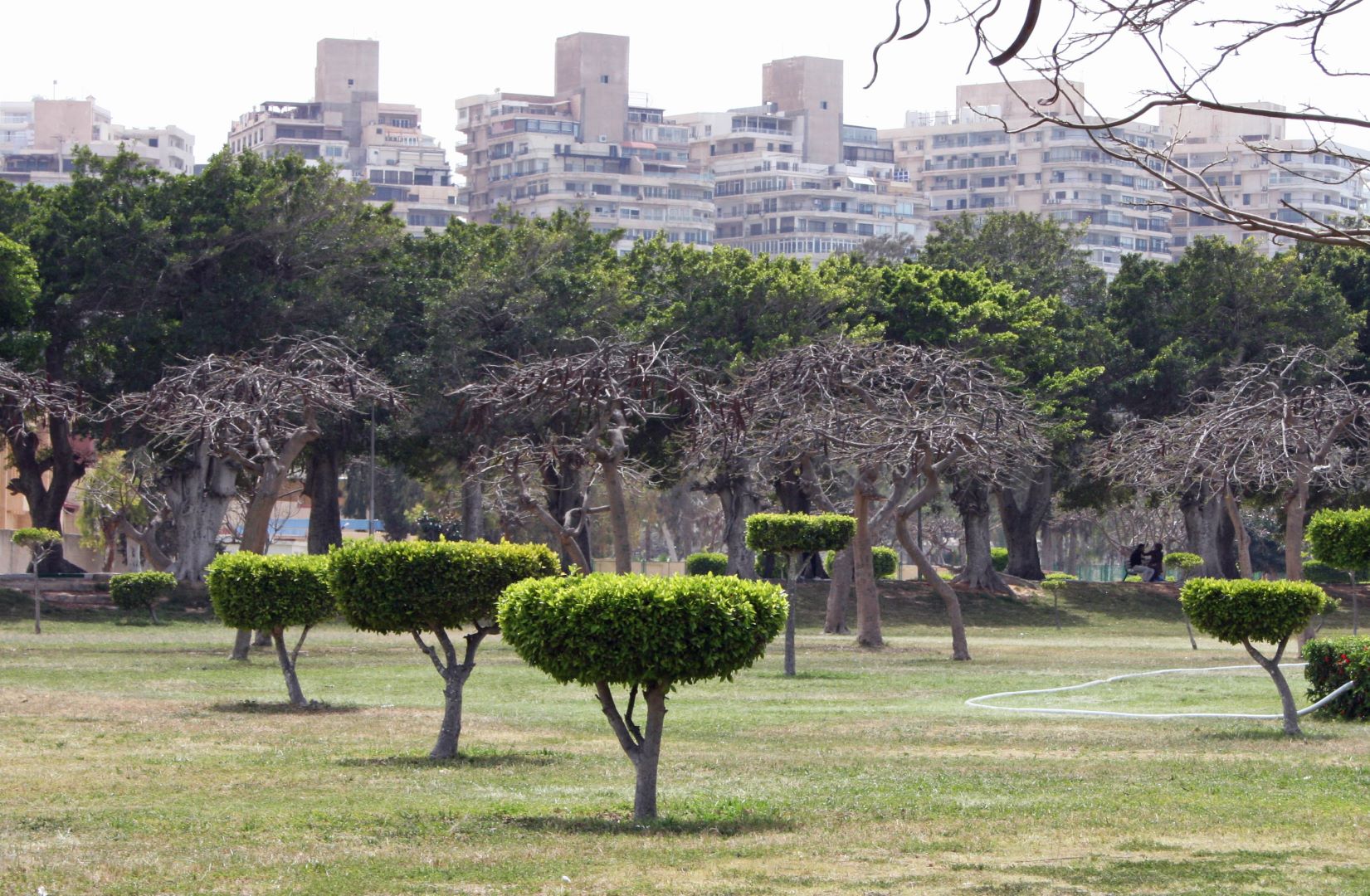The search for the ideal landscape from antiquity to our days
Steffen Krämer
Metadata
Urban Eidos Volume 1 (2024), pages 5–18
| Journal-ISSN: | 2942-5131 |
| DOI (PDF): | https://doi.org/10.62582/RNRI95100P |
| DOI (online): | https://doi.org/10.62582/RNRI95100 |
In an often quoted passage from his famous Epigrams the Roman poet Martial described in the first century A.D. the urban surroundings of his flat on the third floor of a narrow labyrinth of streets and houses in Rome.1 He dreamed of a nearby little square named At the pear tree as his own. Thus he would have a garden around the house to breathe freely and to have his peace. „Rus in urbe“ – „country in the city“ – was Martial’s well-known motto of his wish-dream. Juvenal, his poet-colleague, argumented similarly in his Satires, contrasting the sickening sleeplessness of the noisy capital with the peaceful life in a provincial house with a small garden, which could even serve as a well-kept vegetable garden.2
Both authors thus formulated an antagonism lasting from antiquity to our days, concerning primarily the connection between criticism of and flight from the cities and the longing for the countryside. This aspect should be taken into account when the phenomenon of artificial landscape is considered. Behind the idea of an ideal landscape, especially behind the conception of gardens and parks, there is amazingly often a reserved, sometimes critical, sometimes even negative attitude towards cities and their different urban structure.
The now described way through cultural history from the antiquity to our present time is to document this antagonism. The chosen examples are taken from different spheres and reach from architecture and urban planning to painting and literature. Many of these have not yet been discussed under this point of view, which often makes the explanation difficult, all the more so as this article can hardly provide a comprehensively scientific argumentation. Therefore the given examples are but side-lights, illuminating only a certain aspect in the cultures and epochs referred to.
The idea that planned landscapes should stand out in relief against urban structures was not an invention of the Roman antiquity. Egyptian pharaos already had layed out spacious parks in their residential cities, for instance Amenophis IV, who called himself Echnaton in honour of his God Aton, and his wife Nofretete. In their newly built heliopolis Amarna luxurious gardens – as a symbol of the extraordinary luxury of their royal lifestyle – were integrated in the newly built complex of their royal residencies.3 Thomas Mann, in his tetralogy Joseph and His Brothers, vividly described Potiphars garden in the old-Egyptian Thebes being surrounded by a ring-wall „closing off all eyes and granting solitude“.4 „Paradisiac“ was a part of the palm garden because different sorts of fruit grew there side by side.5 It is not surprising that Thomas Mann used the term „paradise“ as it was already used in ancient times for wonderful gardens.
In the 4th century B.C. the Greek poet Xenophon called in his book Oikonomikos the Persian gardens „paradeisoi“, thereby referring to the old Persian word „pairi-dae’-za“, which means fenced-in or surrounded by walls.6 Thus the demarcation from the surrounding area was from the beginning of garden-culture a significant characteristic and played an important role as distinction from the surrounding urban site.
Nowhere the contrast between city and garden is more evident than in ancient Rome. On the one hand there was the highly concentrated urban centre with its huge overpopulation, on the other the villeggiature with its extended parks situated mostly in the urban periphery and constituting since the late Republic the status symbol of Roman celebrities like Lucull, Sallust or Maecenas.7 The Roman poet Lucrez described in his multi-volume book De rerum natura the feeling of life at such exclusive places in the city as „sedes quietae“. „Nothing is sweeter than to live in cheerful and calm districts, secured in the heights by the teaching of wise men, and to look down on the other people wandering to and fro and searching unsteadily their way of life“.8 Horaz described it more accurately in one of his Odes where he let his eyes wander over the city from a high observation tower in the gardens of Maecenas, thereby marvelling at the happy, sticky, rich and noisy Rome.9 The tradition of large-scale parks from the late Republic was continued during the Roman imperial period, and with the imperial palaces of Tiberius and Domitian, the Palatine, one of the seven hills of Rome, was the privileged place of fashionable gardens.10 From an elevated as well as protected position, one could now view the urban environment with its partly chaotic activities on the Forum Romanum to the north and the Circus Maximus to the south.
But no fashionable complex in Rome had such large dimensions as the famous Domus aurea of emperor Nero in the midst of Rome.11 „Rus in urbe“ was from now on the definitive standard for a large-scale architectural project, comprising from eighty to one hundred hectares and thereby covering a large part of the inner city. With its extensive parks, hang terraces and its artificial lake, the Domus aurea was literally a huge ideal landscape in the centre of Rome. The fact that Nero, as employer, had recognized the utmost contrast between his urban villas and park grounds and the urban conditions with their highly condensed architectural texture, is proved by the emperor´s dictum handed down by the Roman author Sueton: „At last I am starting to live like a human being“.12 In the existing urban form of Rome, the emperor was not able to realize his lifestyle, marked by splendour and luxury; and so it is significant that the free areal for his large-scaled architectural and landscape project was obtained by a city devastation of hitherto unkown proportion. Whether Nero was personally responsible for the terrible conflagration of Rome, completely or partially destroying great parts of the city – as some ancient authors claim – can historically not be proven.13 In any case, the destruction of the inner city of Rome now enabled him to create his ideal landscape. „Rus in urbe“ now no longer expresses the contrast as guiding idea, but a rigid form of destruction.
On a smaller scale there existed in town-houses since the late Republic a hardly surveyable variety of gardens in the form of plantations of the pillars-surrounded patio – the so-called peristyle.14 Even today such closed gardens can be seen in Pompeii, for example the peristyle in the so-called House of Menander (Fig.1), whose pillars are surrounded by low walls, thereby enclosing the garden even within the house. It was destined not only to be entered but first of all to be visually noticed from a distance.
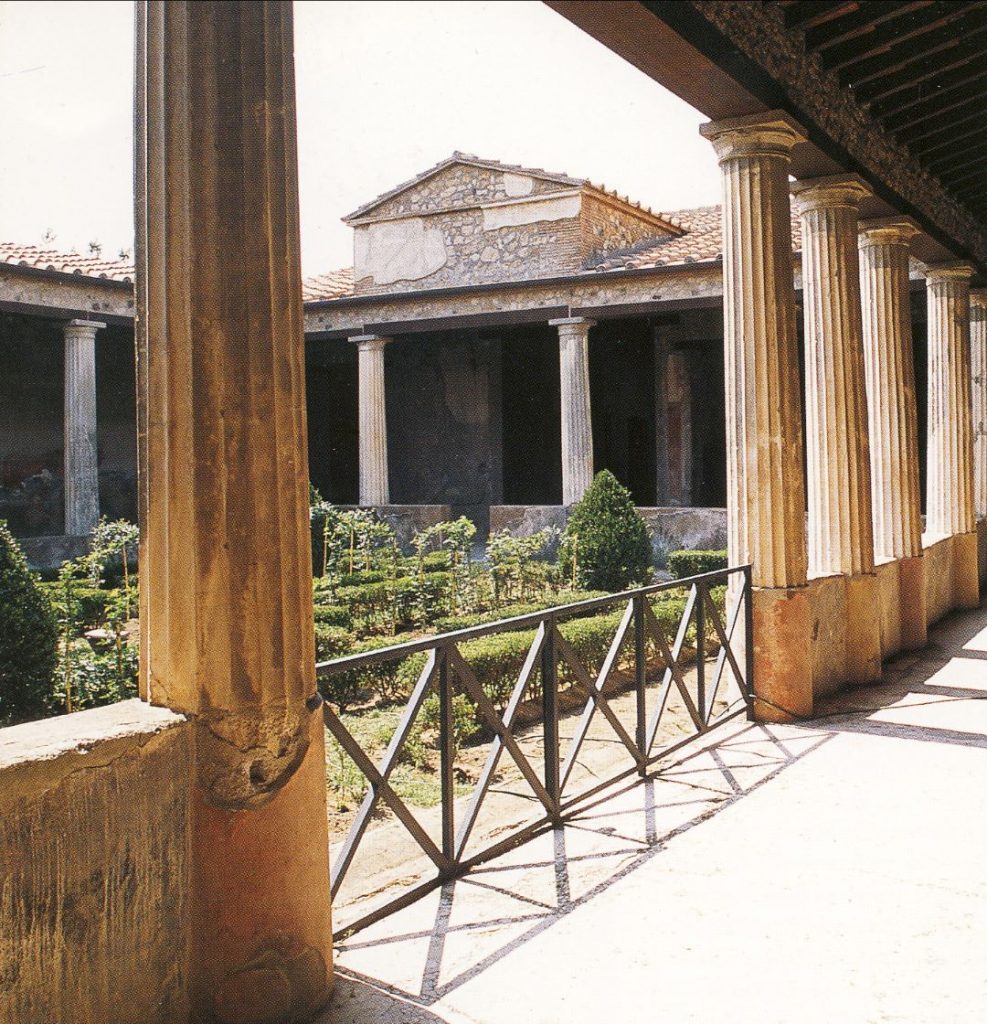
Fig. 1 Pompeii, House of Menander, peristyle
These rather small-scale planted areas within the houses, were not only meant to imitate the large villa gardens and parks.15 A small ideal landscape within the own living quarters was to create a contrast to the city-life on streets and public squares. The house garden surrounded by pillars was therefore a form of privatization of the Roman way of life.
However, this retreat into private life was symbolized by yet another form of artificial nature in Roman villas or dwelling-houses. In Pompeii as well as in Rome antique frescoes have survived covering the entire walls of a room with a splendid landscape of flowers, fruits and animals.16 A famous example from the early imperial time is the excavated garden room in the villa of Livia near Primaporta in the northern part of Rome, today being a part of the Roman National Museum (Fig. 2). This form of wall-painting was supposed to give a hightened sense of living to the inhabitants by suggesting with landscape-paintings an imaginary world, being much more pleasant than urban reality outside the house. You even no longer needed to go to the peristyle of your home or villa. Now a garden painted on the walls was sufficient to create the perfect illusion of an ideal landscape.

Fig. 2 Wall-painting from Livia’s garden room near Primaporta, Rome, Roman National Museum
The demarcation from the outer world is also a main feature of the Islamic garden.17 In several fairy tales of the Arabian Nights – whose oldest Arabic version dates around 1450 – gardens are the scene of the action.18 A magnificent park of the Caliph in Baghdad, known as pleasure garden, is described in the tale of the 213th night. „There was a fence along the path, and at the end of the path there was a garden gate, but it was locked.“ As charming as this garden is portrayed in the fairy tale, as isolated is it from the urban environment, although Baghdad reveals itself as „Paradise“ for the two protagonists in the fairy tale, „adorned for its people, showing its wonders openly at all times“.19
What was meant for Baghdad was also characteristic of the Ottoman capital. Around the middle of the 16th century the German painter and graphic artist Melchior Lorck gave us with his views of the town a vivid picture of Constantinople, the later Istanbul (Fig. 3). They clearly show that the metropolis on the Bosporus, like many other Islamic cities, was interspersed with partially large-scale parks, generally enclosed by high walls.
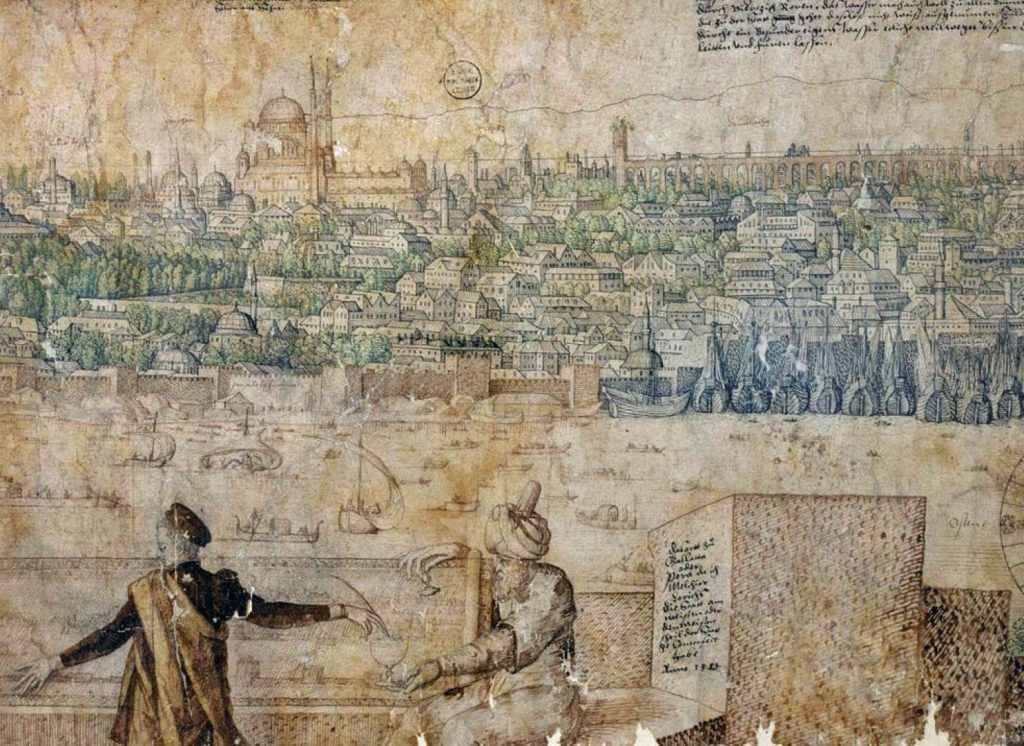
Fig. 3 Melchior Lorck, view of Constantinople, mid 16th century
Many historic sources prove that this refined garden culture was already established about 100 years after the Islamic wave of conquest of the 8th century.20 Only fragments of these early Islamic gardens survived. In order to have an idea of their original form we have to look at gardens from later periods or at modern reconstructions. In the medieval Medina – the old city of Marrakech –
with its labyrinth-like alleys and bazaars a garden was reconstructed in the middle of the 19th century. The origin of this garden goes back to the second half of the 16th century. This garden was opened to the public but in 2016. Both the structure as a whole as the details of this Jardin secret (Fig.4) point to the tradition of Islamic gardens since their beginning. The general conception of rectangular axes dividing the planted areas in four equally large segments, goes back to the preislamic gardens of Persia and is called tschārbāgh – four-part-garden.21
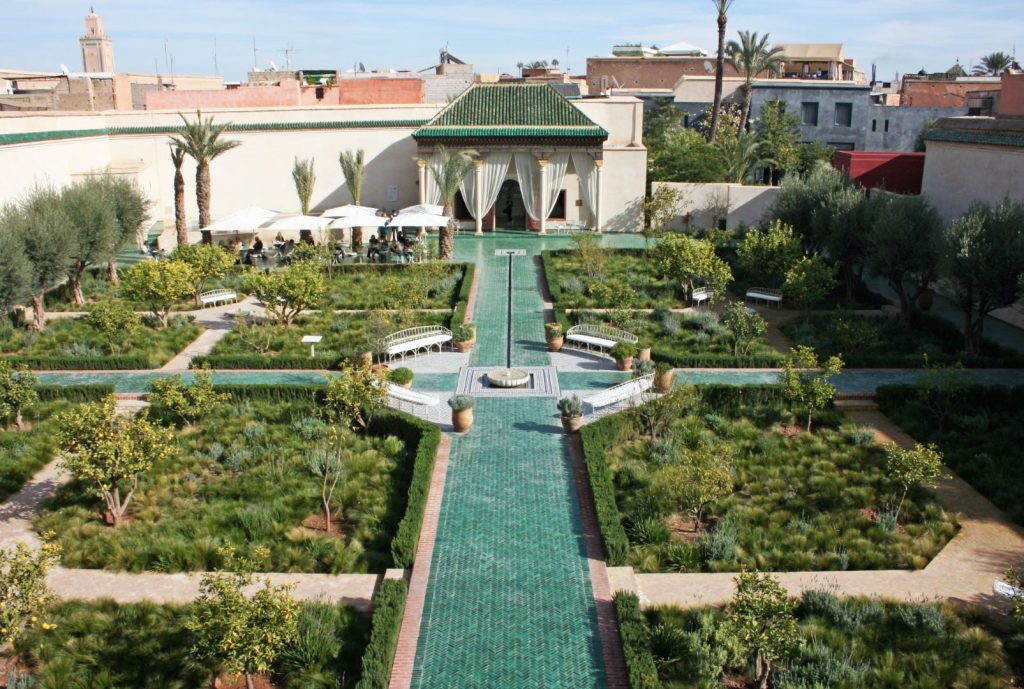
Fig. 4 Marrakech, Le Jardin secret
Scientific studies often point out the formal likeness between Islamic gardens and the religious conception of Paradise, as described in the Quran (Koran).22 Surah 47 speaks of four paradisiacal rivers the faithful will encounter when God has granted them entry. „The Paradise promised to the Godfearing is constituted as follows: brooks with water that is not stagnant, others with milk (still) tasting (fresh), others with wine tasting lovely and still others with clarified honey.“23 The axes, the division into four sections and the water flowing in channels or collected in basins, all these were symbols, making the Islamic garden an image of Paradise, as it were a paradise on earth. Based on symmetry and harmony it had a religious implication and therefore already pointed to the life to come. It is not surprising that the closed Islamic garden always stood in contrast to the profane worldliness of the surrounding city. Even today this contrast can be felt in Marrakech coming from the loud and sometimes chaotic souks of the Medina and encountering the peace and clearness of the Jardin secret (Fig. 4).
These transitions also existed in European Middle Ages, when planted inner courts or closed gardens of a cloister contrasted with the surrounding urban context. Since the Carolingian period there is not only an abundance of monastic examples in European cities but there are also ideal images of such gardens, preserved in literature – Walahfrid Strabo’s hortulus24 – or in form of an ideal design – the plan of Saint Gall25.
The Romance of the Rose, written in the 13th century, is considered the most successful work of medieval French literature. The anonymous author, writing in the first person, reveals already in the first chapter the reason for his springtime wanderings leading him at first to the surrounding countryside. „It drives me from the town in the open air.“26 In the second chapter he describes the destination of his wanderings. „Not far away I saw a large grove enclosed by a wall.“27 This lovely enclosed garden is the subject of the third chapter. Its owner is the fun or the pleasure (déduit). „For this grove is his property and the plants he has settled there have been brought from Saracen land.“28 Shortly afterwards the comparison with the paradisiac garden follows: „This place appeared to me perfect, even heavenly and for all I know there is no heavenly garden giving greater fun than this grove.“29 As usually the subject of the Romance of the Rose is paradise on earth in form of a closed garden the narrator can only reach by fleeing from the city. The plants from „Saracen land“ are another exotic ingredient referring to the well-known tradition of Arabian and Islamic gardens. After all the lovely grove of the Romance of the Rose corresponds to the medieval hortus conclusus (Fig. 5), however desecrated by the love of Venus and Amor.30
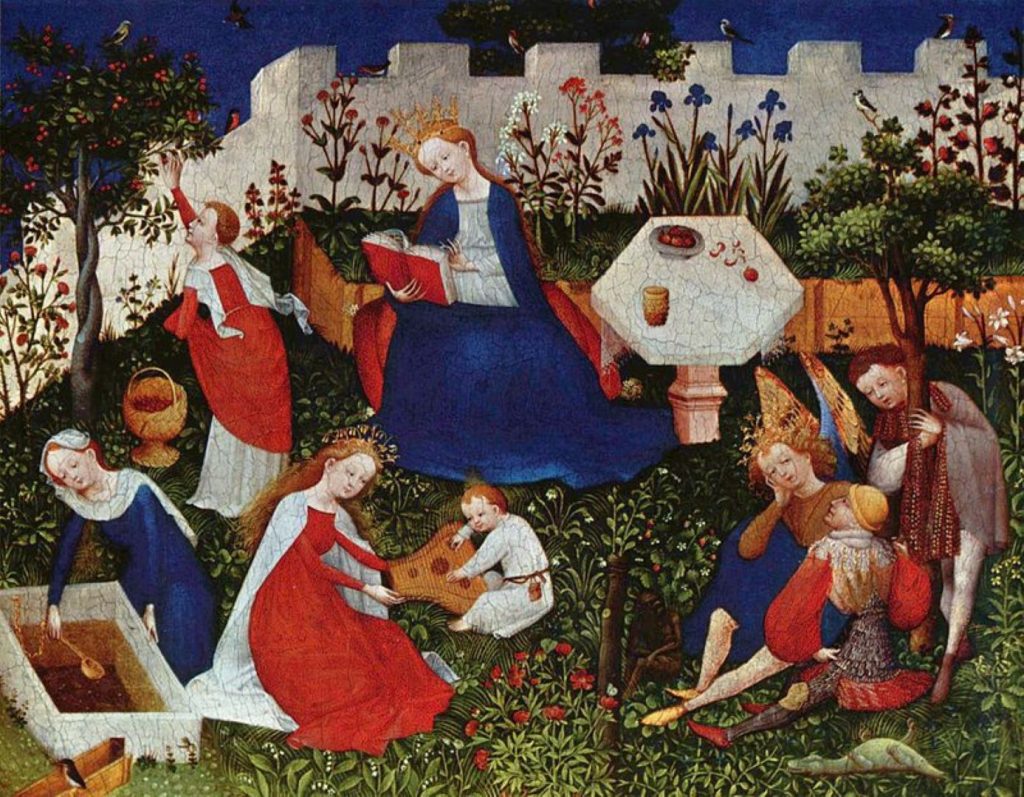
Fig. 5 Upperrhine master, Small paradisiac Garden, approx. 1410, Frankfurt/M, Städel Museum
In Decamerone, a novel of Giovanni di Boccaccio from the middle of the 14th century, the connection between flight from the city and love for the countryside is fully dramatized. The historic reason for the flight of a group of young men and women from Florence is the plague of 1348. In the „devastating situation of our city“ they decide to flee to their country estates, in order to escape from death. „There one can hear the singing of the birds, there one can see the green of the hills and the plains, there one can see the abundant cornfields waving like the sea, there one can see thousands of different trees and the open sky which – even if angry – it never betrays its everlasting beauty: all this is much more beautiful than the empty walls of our city.“31 The destination of their dramatic trip was a lordly villa on a remote hill, „with meadows all around and with marvellous gardens.“32 Now the merry life of the „happy company“ newly begins, at first in the garden „to bind wreathes with different foliage and to sing love-songs“.33 Joy of life and delight – this is the essential meaning of Decamerone’s text – can be regained in times of the plague only by fleeing from the city to a far-off garden.
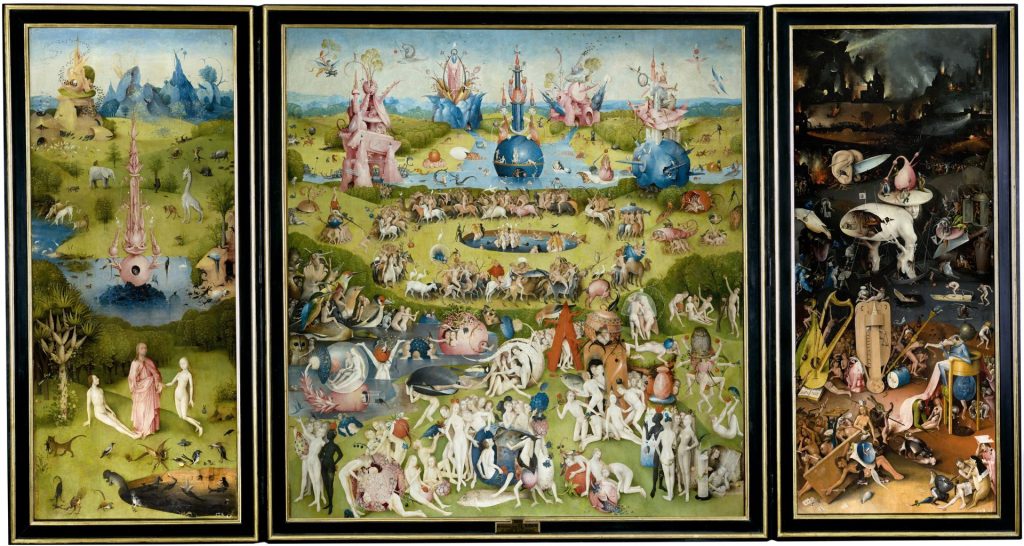
Fig. 6 Hieronymus Bosch, Garden of Earthly Delights, end of 15th or beginning of 16th century, Madrid, Museo Nacional del Prado
The most extraordinary contrast of city and garden in European late medieval art can be found in the pictures of Hieronymus Bosch. The largest subsisting painting is the so called Garden of Earthly Delights, a huge triptychon from the end of the 15th or the beginning of the 16th century, showing on the left panel the history of creation from Genesis, on the right panel the representation of hell (Fig. 6). What the painter wanted to display on the middle panel is even today controversely discussed by experts.34 The paradise-like landscape typical for Bosch does not correspond with nature as it is, but rather with a strangely animated rural panorama, where a multitude of diverse animal species form a unity with God and the first pair of human beings. Hans Belting speaks in this context of an „imaginary“ or „idealized nature“.35 The negative image is the obscure world of hell with its countless demonic hybrid beings punishing the humans for their sins with innumerable sorts of pains.
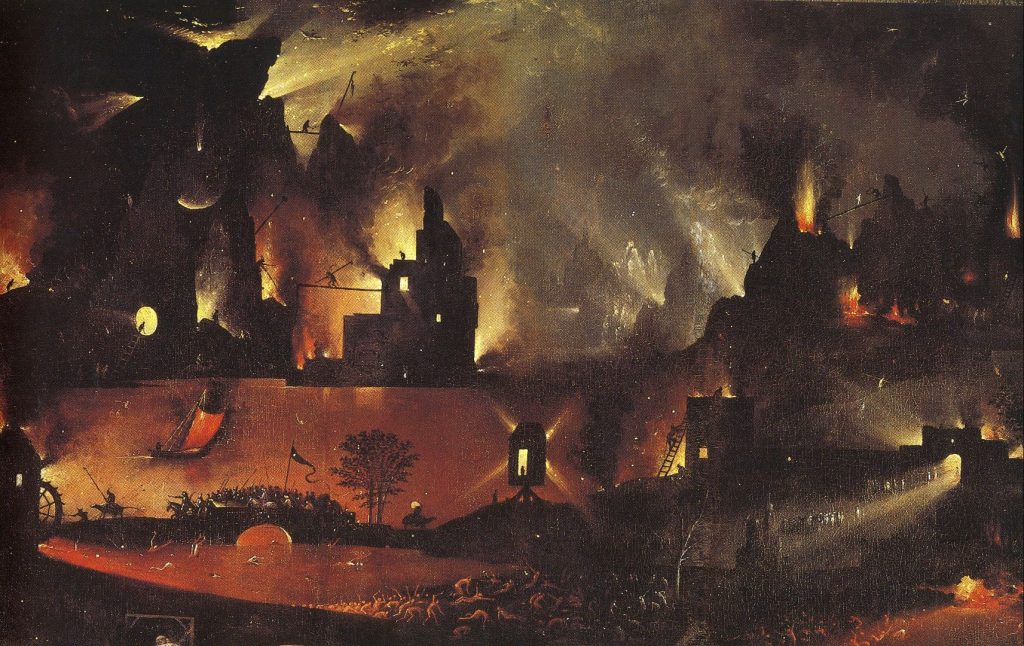
Fig. 7 Hieronymus Bosch, Garden of Earthly Delights, right-hand panel, upper part
This bizarre pandemonium reaches its climax by the ghostly scenery of burning cities, well known to the people of the Middle Ages, who were constantly confronted by war and devastation (Fig. 7). The two side panels oppose the harmonic ideal of a paradisiac garden to the tragic reality of urban katastrophies.
Less dramatic but equally pronounced is the antagonism between idyllic rural life and urban crises still in the late 18th century. Louis-Sébastien Mercier described in the eleventh volume of his Tableau de Paris the French capital as an „amphitheatre of latrines“ – „amphithéâtre de latrines“ – „spreading around the worst stench“.36 The horrible pollution of the public quarters was also perceived with disgust by other contemporaries of Mercier and was answered by the urban population with the creation of gardens.37 „The landscape is embellished by the parks of the nobility, and the outskirts of the cities by the gardens of the citizens.“ With this concise expression the famous horticultural theorist Christian C. L. Hirschfeld characterized the situation in the 5th volume of his Theory of Horticulture.38 The fact that another reason of his appeal for the creation of private gardens in the city was the terrible stench is proved by the following sentence: „The destination of flower-gardens is to delight the eye with the diversity and beauty of colours combined with the amuse-ment of the sense of smell.“39
Only a few years later a special form of the ideal landscape was established, correlating with the technical innovations of early industrialization and influencing the appearance of the cities. In the 19th century the serial production of iron and glass made it possible to develop large-scaled greenhouses, put up not only in the parks of European country estates but also in the immediate surrounding of urban housing areas.40 These delicately transparent iron-glass-constructions were used as winter gardens, palmeries or hot-houses for tender or exotic plants. They often had an artificial mikroclimate, clearly marking off the guarded interior from the outside world. Already in 1845 Alexander von Humboldt described the peculiar atmosphere of a palm house in the first volume of his book Kosmos: „You have the impression to be in a tropical climate and to look from the top of a hill at a small bushy palm thicket.
Of course, the view of the dark blue sky is lacking, as well as the impression of a greater intensity of light. However, here the imagination is even more active, the illusion even greater than with the most perfect painting.“41
The effect of these artificial paradises was all the more intensive the more they were differentiated from the surrounding area.42 In the city they were like a dream world providing the owner or the visitor with a proper refuge for strolling around or living out his imaginations. Thus the exotic interiors of the private green-houses were offering a certain freedom from the social demands of the 19th century.
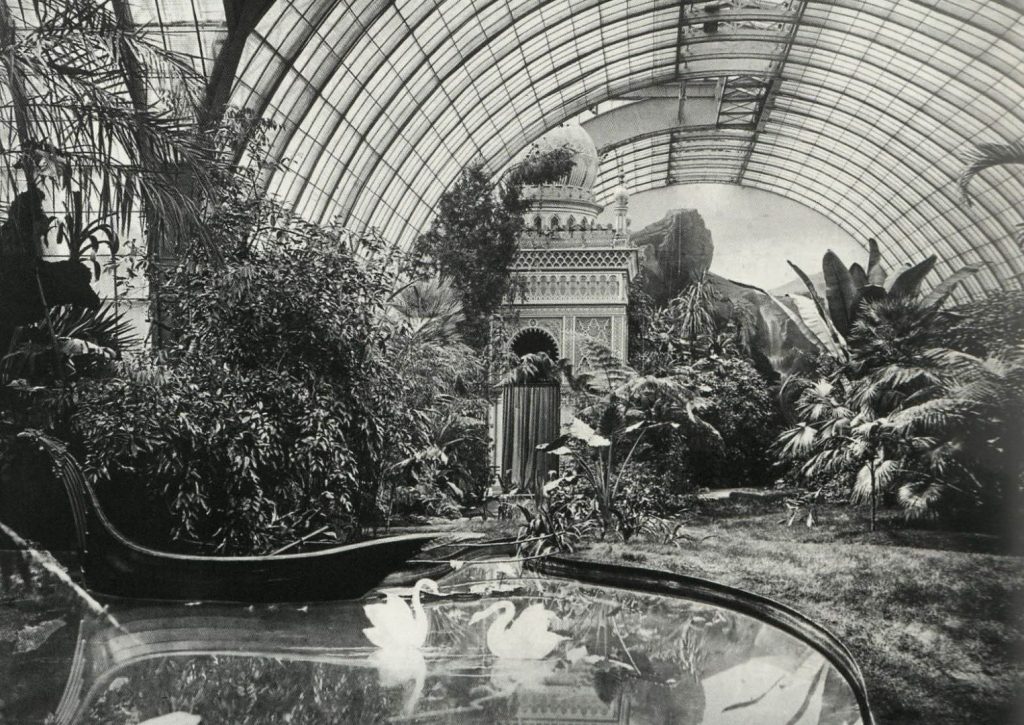
Fig. 8 Munich, royal palace, winter garden of Ludwig II, historic photo
A famous example is the winter garden king Ludwig II had built after 1867 on the roofs of his residency in Munich, extending over the northern roofs to the Hofgarten (Fig. 8).43 As it was directly accessable from his study, the king often withdrew to this artificial landscape fitted out with a Moorish kiosk, an Indian royal tent and a panoramic view of the Himalayan mountains. Sometimes artists were invited to the winter garden for „private audiences“, making perfect the suggestion of the king’s theatrical counter world over the roofs of Munich.
Furnishing the private rooms with exotic plants and flowers was the reduced version of these artificial landscapes. In his novel Against Nature: A Rebours, published in 1884 Joris-Karl Huysman had his excentric leading person, the French nobleman Jean Floressas Des Esseintes equipped his extraordinary private house with a „wonderful collection of tropical plants“.44 This floral presentation was meant not so much as an imitation of nature but rather as an illusion surpassing nature by a perfectly arranged artificial form. „These plants are highly disturbing he said; then he stepped back and overlooked the whole arrangement: he had reached his goal; not a single flower seemed to be real; material, paper, porcellan and metal were lent to nature from man, in order to give nature a chance to create its monsters.“45 Once this highly artificial flowery composition was finished Des Esseintes lost his interest. The plants wilted and were removed from his rooms. His own decadency had dulled his sensibility for their exotic forms and colours.
At the end of the 19th century the situation of life in European cities grew more and more precarious, especially for the poorer classes. Around the middle of the century numerous engaged descriptions had been published denouncing the social misery and the desolate housing conditions of the inner cities with its utmost density of population.46 From now on the ideal landscape was no longer seen as a contrast to the complex form of the city, but as its fundamental alternative. Just before the turn of the century the English social reformer Ebenezer Howard provided with his concept of the Gartenstadt a serious urban vision, promising a way out of the deep dilemma the European large towns and industrial cities were in. His book Tomorrow. A Peaceful Way to real Reform, first published in 1898 and newly edited four years later under the more concise title Garden Cities of Tomorrow containes his all-comprising reformatory theory and was provided with diagrams.47 The garden city is an early form of the satellite city, built for a limited number of inhabitants. Once the maximum was reached, another city was to be built – thus slowly forming a concentric ring around the basic city and reducing the pressure. Howard fundamentally propagated a small-town principle based on the strict reduction of urban housing, garanteeing large green zones in the centre and extensive ones in the periphery. The chaotic growth of the large cities was opposed by the garden city with its regulated nature in the form of private gardens and public parks. Every inhabitant now had his own small-sized ideal landscape which he could plant according to his own wishes. The longing for rural tranquility, already described in antiquity by Roman writers as Martial or Juvenal, was coming true by the garden city.
The equalization of the ideal landscape and the urban structure was established in modern town planning after World War I. In connection with his urban utopia, the so-called Ville Radieuse being planned since 1930, Le Corbusier used the term „green city“ – „ville verte“.48 How innovative this urban idea was he expressed in a letter dated March 1930: „I was the first to declare that the modern city has to be a huge park, a green city.“49 In 1935 the architect reduced his vision to the linguistic formula: „The green city = La Ville Radieuse“.50
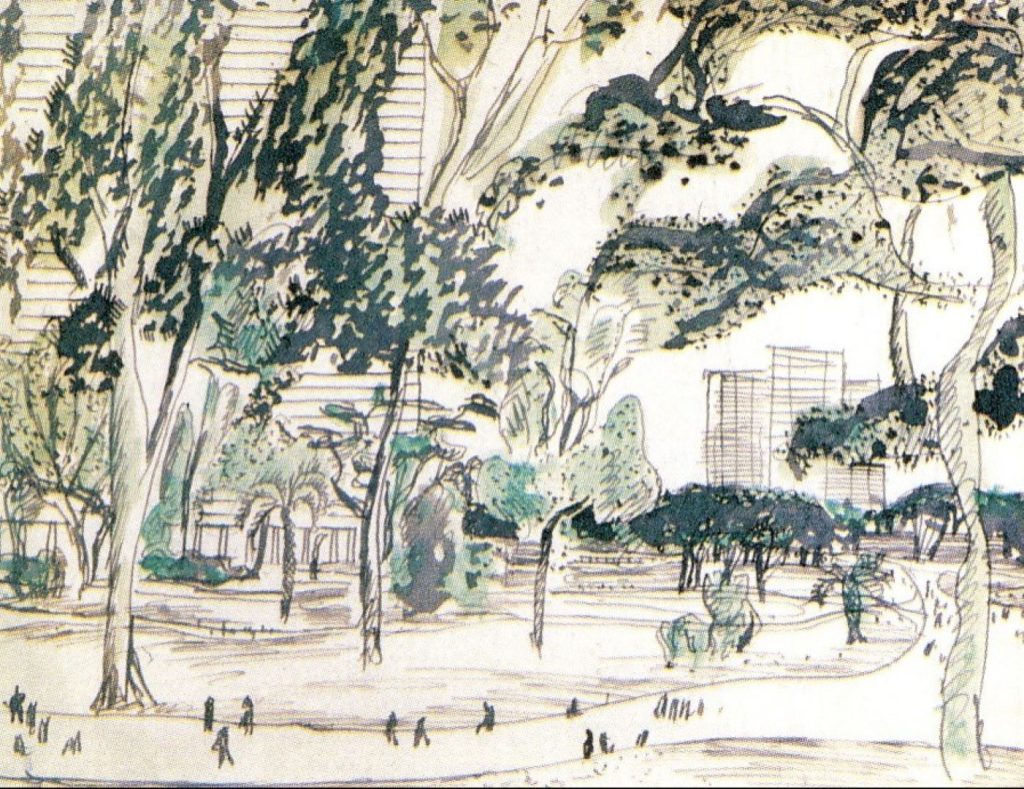
Fig. 9 Le Corbusier, La Ville Radieuse, 1930, sketch
Plans and sketches for La Ville Radieuse document that the fundamental idea behind the utopian city was a reduced density of houses in favour of extensive parks (Fig. 9). Point high-rise buildings and linear rows of houses were loosely distributed on a green setting where the line of the tall trees was extended by the high-rise buildings. The inhabitants of the Ville Radieuse were to find a park-like surrounding, totally different from the urban chaos of the existing cities.
Le Corbusier’s Ville Radieuse was of decisive importance for the famous Charta of Athens passed as official resolution by the delegates of the 4th CIAM-congress in 1933 because it constituted the leading principle of the concept listed in the 95 paragraphs of the document.51 This is not really surprising as the resolution as a whole was set up under the aegis of Le Corbusier. Paragraph 35 is defining the urban structure of the new city as follows: „The fabric of the city meant is the historic city, author’s note has definitely to change its texture; the heaps of stone will turn into green cities.“52 The contents of the Charta of Athens were to become the most important theoretical basis for urban planning after World War II. Le Corbusier’s vision of „the green city“ was internationally consolidated after 1945.
However, as the countless residential and satellite settlements from post-war time until the early seventies show the equalization of city and park had fatal consequences. The sometimes huge settlements were obviously lacking urban qualities and the green areas as well as the sometimes extensive building complexes were usually totally indifferent and irrelevant. It almost seems that by trying to equate the city with the park their particular values were levelled, while they are increased by their opposition.
In the last decades this antagonism can again be noted, manifesting itself in all sorts of worldwide variations. The longing for the private garden as formulated already by ancient Roman authors – be it within the own premises or at least in their direct vicinity – was to become a leading motif of the so called New Urbanism, developed in the USA since the end of the eighties.53 The marking off from the outside world, a main characteristic of the Islamic garden, is also to be noticed in the present Arabian world. As in former times it is still a sign of wealth and a privilege to reside in the luxurious gardens of private villas, exclusive hotels or Gated Communities (Fig. 10).

Fig. 10 Kairo, highway-advertisement for a Gated Community on the northern outskirts of the town
Artificial paradises with their ideal landscapes are created all over the world. They are often cut off from the outer city. Only by this frontier their illusionistic energy is secured. However, as a refuge for strolling about or for living in imaginations they are no longer unique, as the dream worlds of glassed-in gardens can be perfectly used for consumption. New shopping malls are therefore equipped with elaborately arranged green zones under transparent roofs and cupolas, where visitors can linger in cafés and restaurants (Fig. 11). Therefore these protected artificial gardens are an important part of a skillful selling strategy, because resting under exotic trees or palms intensifies the individual sense of life and consequently the delight in consumption. However they cannot compete with the splendid and exotic greenhouses or winter gardens of the 19th century, being but a reduced form, a somehow simplified plagiarism of them.
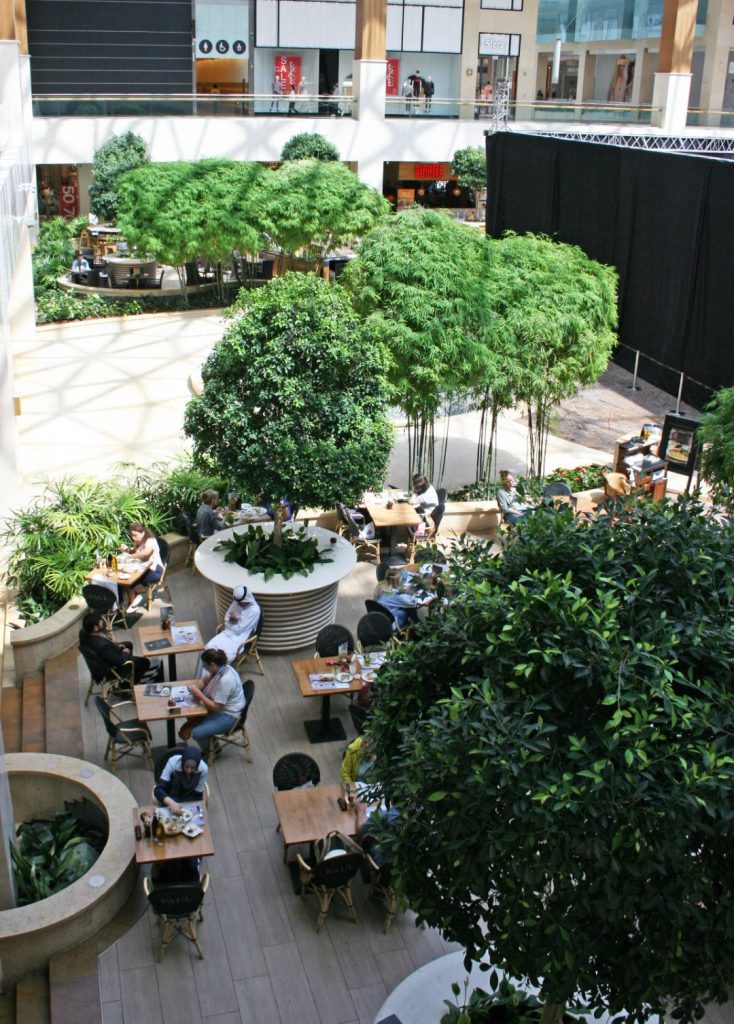
Fig. 11 Abu Dhabi, Yas Mall, green zone in glass-covered lounge area
„Rus in urbe“ – „country in the city“ – was not only a wish-dream in antique times but continued to be so in different forms and intensities throughout the epochs of our cultural history. As a rule it was an antagonism uniting criticism of the city with longing for the countryside. Only with modern town planning grew the intension to eliminate this marked contrast; the results were however dubious considering the constructed monotony of the numerous satellite towns and park settlements of the fifties and sixties.
Nowadays spacious parks are again created in cities urgently needing green areas because of their extreme architectural density. In 2005, in central Kairo, the Al-Azhar-Park with a surface of thirty hectares was opened to the public. The fenced-in park is situated immediately beside the Darb al-Ahmar quarter, one of the poorest quarters of Kairo without refuse disposal and sanitary installations. Although the entry fee is extremely low, the inhabitants of the neighbouring poor district can hardly afford a visit of the park.
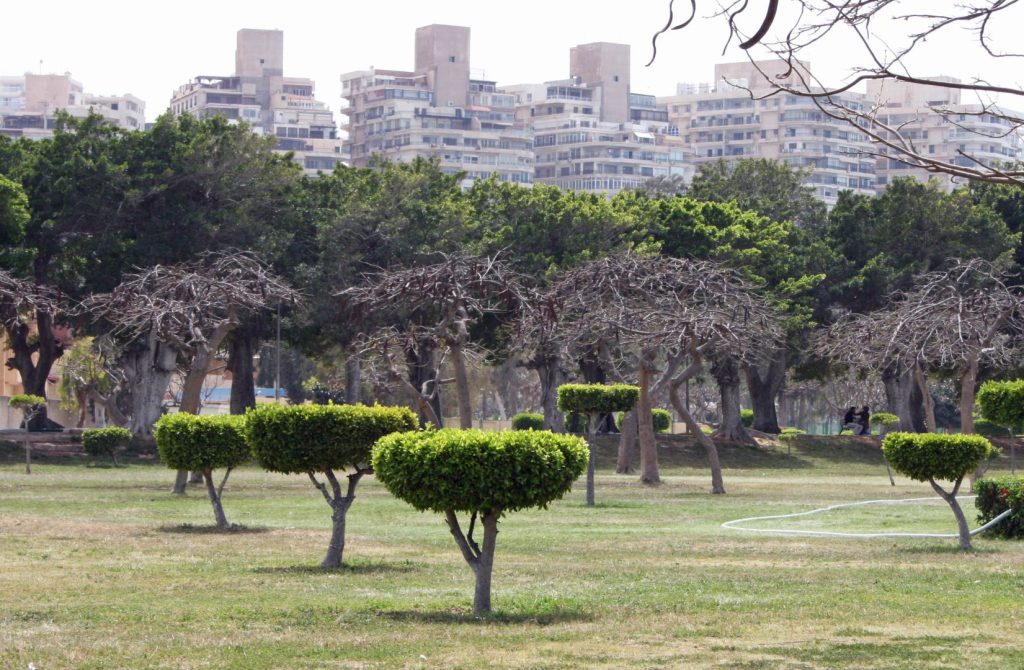
Fig. 12 Alexandria, Montazah Park
Similarly the Montazah-Park in Alexandria, originally being a lordly estate was opended to the public (Fig. 12). This park however is strictly guarded like a Gated Community prohibiting access to the poorer population, because the expensive luxury hotels are situated there. The outskirts are built over with closely set tower-like apartment-houses, already dilapidated, a view characteristic for the generally desolate view of modern Alexandria. Nowhere else the contrast between large park areas and dense urban structure could be more evident.
With these current Egyptian examples ends a line of traditions, beginning with the ancient Pharaonic gardens and continuing thousands of years. Thomas Mann has named their form „paradisiac“ and the conception of paradise on earth has obviously been the fundamental principle of many parks and gardens described in this paper.54 Alternatively all these enclosed gardens can be seen as a remote reflex of the paradise lost John Milton described in his homonymous book of 1667.55 For Michel Foucault however the garden was the oldest example of the heterotopia.56 „The totally different spaces“ – as he calls the heterotopias – are often „isolated from their surroundings“ or „totally marked off from the external world“.57 These two fundamental qualities of a garden – otherness and demarcation – are only completely evident if its ideal landscape is completely set off from the urban structure of the city. Accordingly, this by now well known antagonism is equally present in Foucault´s „pleasant fields of utopia“.58
English Translation
Ulrike Lutter, Munich, Winckelmann Akademie für Kunstgeschichte
Illustration Credits
Fig. 1-4, 8, 10-12 Munich, Winckelmann Akademie für Kunstgeschichte, Image Archive
Fig. 5 Städelsches Kunstinstitut und Städtische Galerie, Verzeichnis der Gemälde, Frankfurt/M. 1987, Fig. 27
Fig. 6 Hans Belting, Hieronymus Bosch. Garten der Lüste, München a.o. 2002, 10-12
Fig. 7 Wilhelm Fraenger, Hieronymus Bosch, Dresden/Basel 1991, Fig. 11.
Fig. 9 Vittorio Magnago Lampugnani, Die Stadt im 20. Jahrhundert. Visionen, Entwürfe, Gebautes, Vol. 1, Berlin 2010, 398.
- Martial, Epigrams, Book 12, Chapter 57/21. ↑
- Juvenal, Satires, Satire 3. ↑
- For the old-Egyptian gardens see Toby Musgrave, Paradise Gardens. Spiritual Inspiration and Earthly Expression, London 2015, 17-27; Karin Dzionara, Der Garten im alten Ägypten, in: Hans Sarkowicz (Ed.), Die Geschichte der Gärten und Parks, Frankfurt/M./Leipzig 1998, 27-39. ↑
- Thomas Mann, Joseph und seine Brüder, Vol. 2, Joseph in Ägypten, Frankfurt/M. 1975, 583, 620, 634f., 639f., 642f., 661. For the quote see 642. ↑
- Mann, Joseph in Ägypten (see note 4), 661. ↑
- Xenophon, Oikonomikos oder vom Haus-Wesen, translated by Barthold Henrich Brockes, Hamburg 1734, Chapter 4, § 13, 39. For his derivation from the old-Persian see Peter Cornelius Mayer-Tasch, Der Garten Eden, in: Sarkowicz, Geschichte (see note 3), 13-26, here 14; Sandy Alami Hassani, Der islamische Garten. Eine Entwicklung über mehrere Kontinente, Hamburg 2014, 2. ↑
- For the mentioned gardens and villas of the late Republic in Rome see Bernard Andreae, „Am Birnbaum“. Gärten und Parks im antiken Rom, in den Vesuvstädten und in Ostia, Mainz 1996, 67-89. ↑
- Lukrez, Über die Natur der Dinge, Book 2, Preface, 10. For the notion „sedes quietae“ see Andreae, Am Birnbaum (see note 7), 76. ↑
- Horaz, Odes and Epodes, Book 3, Ode 29, Chapter 10. ↑
- For the imperial palaces on the Roman Palatine see Adolf Hoffmann, Ulrike Wulf, Die Kaiserpaläste auf dem Palatin in Rom. Das Zentrum der römischen Welt und seine Bauten, Mainz 2006. ↑
- For Nero’s Domus aurea see Filippo Coarelli, Rom. Ein archäologischer Führer, Freiburg 1975, 198-204; Harald Mielsch, Die römische Villa. Architektur und Lebensform, München 1987, 64-68. ↑
- Sueton, The Twelve Caesars, Nero, Chapter 31. ↑
- For this assertion see Tacitus, Annals, Book XV, Chapter 38-42, and Pliny the Elder, Natural History, Book 17, Chapter 5. ↑
- For the gardens of the Roman town-houses see Christian Meier, Der römische Garten, in: Sarkowicz, Geschichte (see note 3), 93-107. ↑
- Paul Zanker, Pompeji. Stadtbild und Wohngeschmack, Mainz 1995, 174-181, has already referred to this idea. ↑
- For this Roman wall-paintings see Andreae, Am Birnbaum (see note 7), 64-66; Zanker, Pompeji (see note 15), 190-210. These antique frescoes are an early example for the tradition of garden-paintings, decorating especially the private interiors of the 19th and 20th c.; see Sabine Schulze (Ed.), Gärten. Ordnung, Inspiration, Glück, exhibit. cat., Ostfildern 2006. ↑
- See Hassani, Garten (see note 6), 4; Rainer W. Kuhnke, Byzanz und die Islamischen Gärten, in: Sarkowicz, Geschichte (see note 3), 108-123, here 114f. ↑
- For the mentioned fairy tales of the Arabian Nights see Tausendundeine Nacht, translated by Claudia Ott, München 2004, 188f., 317, 389f., 509, 522-533. ↑
- For the two quotes see Tausendundeine Nacht (see note 18), 522f. ↑
- For the early history of the Islamic gardens see Thomas Leisten, Der Garten im Vorderen Orient. Das vorislamische Erbe islamischer Gartenanlagen, in: Die Gärten des Islam, exhibit. cat., ed. by Hermann Forkl a.o., Stuttgart 1993, 56-59. ↑
- For the history and structure of the tschārbāgh – also written charbagh or tschahār bāgh – see Annemarie Schimmel, Kleine Paradiese. Blumen und Gärten im Islam, Freiburg 2001, 10f., 20; Kuhnke, Byzanz (see note 17), 117. ↑
- See Thomas Leisten, Die Gärten des Islam. Das islamische Paradies als Idealbild des Gartens, in: Gärten des Islam (see note 20), 47-55; Kuhnke, Byzanz (see note 17), 113-116; Schimmel, Paradiese (see note 21), 16-27; Hassani, Garten (see note 6), 5-7. ↑
- Der Koran Quran, translated by Rudi Paret, Stuttgart a.o. 1979, Surah 47/15, 358. For other Surahs with the theme of the paradise garden or generally gardens see Surahs 13, 55, 56. ↑
- Walahfrid Strabo, De cultura hortorum. Über den Gartenbau, ed. by Otto Schönberger, Stuttgart 2015. For Strabo’s didactic poem – dated approx. 840 A.D. and shortly called hortulus – see Michaela Kalusok, Gartenkunst, Köln 2003, 41f.; Herbert Heckmann, Walahfrid Strabos Hortulus – der ideale Klostergarten, in: Sarkowicz, Geschichte (see note 3), 124-135. ↑
- For the the plan of Saint Gall – dated approx. 820-30 A.D. – see Bruno Reudenbach (Ed.), Karolingische und Ottonische Kunst, Geschichte der bildenden Kunst in Deutschland, Vol. 1, München a.o. 2009, 408, with specification of subsequent literature. ↑
- Heinrich Fährmann, Das Gedicht von der Rose, Berlin 1839, 7. ↑
- Fährmann, Gedicht (see note 26), 9. ↑
- Fährmann, Gedicht (see note 26), 28. ↑
- Fährmann, Gedicht (see note 26), 30. ↑
- For the Christian interpretation of the Romance of the Rose see Karl August Ott, Der Rosenroman, Darmstadt 1980, 124-127. ↑
- Giovanni di Boccaccio, Das Dekameron, translated by Albert Wesselski, Vol. 1, Frankfurt/M. 1989, 13, 23. ↑
- Giovanni di Boccaccio, Dekameron (see note 31), 27. ↑
- Giovanni di Boccaccio, Dekameron (see note 31), 29f. ↑
- The iconography of the middle panel is not subject of the article, see therefor especially Hans Belting, Hieronymus Bosch. Garten der Lüste, München a.o. 2002; Nils Büttner, Hieronymus Bosch, München 2012, 99-106; Stefan Fischer, Jheronimus Bosch, Köln 2016, 101-120. ↑
- Belting, Hieronymus Bosch (see note 34), 54. ↑
- Louis-Sébastien Mercier, Tableau de Paris, Tome XI, Amsterdam 1788, 54. ↑
- In his Essai sur la propreté de Paris, Paris 1797, 18, Pierre Chauvet has described the French capital as the „centre of stench“ – „centre de la puanteur“. For the pollution of the public space in Paris in the 18th c. see also Alain Corbin, Pesthauch und Blütenduft. Eine Geschichte des Geruchs, Berlin 1984, 40-52. ↑
- Christian C. L. Hirschfeld, Theorie der Gartenkunst, Vol. 5, Leipzig 1785, 48. ↑
- Hirschfeld, Theorie (see note 38), 60. ↑
- For the close connection of housing area and greenhouse see Corbin, Pesthauch (see note 37), 250f. ↑
- Alexander von Humboldt, Kosmos. Entwurf einer physischen Weltbeschreibung, Vol. 1, Stuttgart/Tübingen 1845, 97. ↑
- For the term of the artificial paradise see Stefan Koppelkamm, Künstliche Paradiese. Gewächshäuser und Wintergärten des 19. Jahrhunderts, Berlin 1988, 47-50. ↑
- For the winter garden of Ludwig II in the royal palace of Munich see Michael Petzet, Gebaute Träume. Die Schlösser Ludwigs II. von Bayern, München 1995, 38f; Jean Louis Schlim, Ludwig II. Traum und Technik, München 2010, 34-53. ↑
- Joris-Karl Huysmans, Gegen den Strich, Zürich 1981, 177-194, here 177. ↑
- Huysmans, Gegen den Strich (see note 44), 184. ↑
- For this urban theme see Steffen Krämer, Entartung und Urbanität. Krankheits- und Verfallsmetaphorik als Grossstadtkritik im 19. und 20. Jahrhundert, in: Forum Stadt, Year 39, 3/2012, 225-254, here 233-236, with specification of subsequent literature. ↑
- Ebenezer Howard, Garden Cities of To-Morrow, London 1902; see also Ebenezer Howard, Gartenstädte von morgen. Das Buch und seine Geschichte, ed. by Julius Posener, Frankfurt/M./Berlin 1968. ↑
- Le Corbusier & Pierre Jeanneret, Œuvre complète, 1934-1938, Zürich 1986, 33. ↑
- Le Corbusier in a letter to M. J. Ghinsbourg, Moscow, March 1930, quoted after Thilo Hilpert, Die Funktionelle Stadt. Le Corbusiers Stadtvision – Bedingungen, Motive, Hintergründe, Braunschweig 1978, 163. ↑
- Le Corbusier, La Ville Radieuse, 1935, quoted after Hilpert, Stadt (see note 49), 163. ↑
- For the Charta of Athens see Thilo Hilpert (Ed.), Le Corbusiers »Charta von Athen«. Texte und Dokumente. Kritische Neuausgabe, Braunschweig 1988. ↑
- Hilpert, Le Corbusier (see note 51), 138. ↑
- Peter Katz, The New Urbanism. Toward an Architecture of Community, Portland/Oregon 1994. ↑
- Mann, Joseph in Ägypten (see note 4), 661. ↑
- John Milton, Paradise lost, Book 4, Verses 179-212. ↑
- Michel Foucault, Die Heterotopien. Der utopische Körper, Berlin 2017, 10f., 14f. ↑
- Foucault, Heterotopien (see note 56), 11, 18. ↑
- Foucault, Heterotopien (see note 56), 9. ↑
